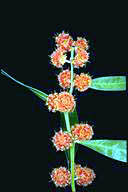

 |
Australian National Botanic Gardens
|
 |
A weekly news sheet prepared by a Gardens' volunteer.
Numbers in square brackets [] refer to garden bed Sections.
Plants in flower are in bold type.
1 October 2004
 |
|
Acacia 'Scarlet
Blaze' - click for larger image
|
As spring advances more and more plants are coming into flower. The walk this week follows the Main Path. Take a moment to admire the colourful display in pots at the Visitor Centre entrance.
Walking along the Main path, on the left you soon come to the well-named Philotheca ‘Profusion’ [Section 212] with its white wax flowers, Acacia menzelii [Section 212], and Hairy Guinea Flower Hibbertia vestita [Section 212], both with yellow flowers. On the right are brilliant red Darwinia ‘Mondurup Bell’ [Section 174], orange and pink flowered Bearded Bush-Pea Pultenaea aristata [Section 174], Graceful Zieria, Zieria formosa [Section 174], a large spreading shrub with pink flowers and grey woolly trilobed leaves, and White Flowered Woollsia Woollsia pungens [Section 174] with its spiky leaves. At the far end of this bed is Rulingia cuneata [Section 174], a tall shrub with a profusion of bright yellow flowers overtopping Grevillea ‘Flame ‘n Beauty’ [Section 174].
Continuing past the café, at the entrance to the Friends Lounge the unusual Acacia leprosa ‘Scarlet Blaze’ [Section 131] with its red flowers can be seen. The original plant is unfortunately now dead, probably because so many cuttings were taken from it. At the end of the Ellis Rowan Building on your right the well named Winged Wattle Acacia alata [Section 240] with its pale cream flowers can be seen. The broadly winged stems have taken over the function of leaves.
 |
|
Acacia alata
- click for larger image
|
Continuing on the Main Path past the Daisy Section to Section 30, on the left are Eriostemon ‘J. Semmens’ [Section 30] with its stunning double white flowers and pink buds and the purple pea Hardenbergia violacea ‘Mini Haha’[Section 30]. On the right is the narrow shrub Scott River Jug Flower Adenanthos detmoldii [Section 30] next to the spiky Urchin Dryandra Dryandra praemorsa var. praemorsa [Section 30], both with yellow flowers. Next on the left is the low crimson flowered Grevillea ‘Tanunda’ [Section 30] next to the ground-hugging yellow flowered Dryandra fraseri [Section 30]. Then on both sides of the path is golden flowered Grevillea alpina (Goldfields Form) [Section 30]. Keep a lookout for honeyeaters that love the nectar of the grevilleas. You may also see bees, which cannot pollinate grevilleas, but steal the nectar.
Continuing on there are more grevilleas – white flowered Grevillea ‘Cara Lynn’ [Section 25], orange flowered red Grevillea ‘Poorinda Adorning’ [Section 24], ground-hugging and spiky, pinky red flowered Woolly Grevillea Grevillea lanigera (Prostrate Form) [Section 24], white flowered Grevillea biternata sens. lat. (in the broad sense) [Section 24], white flowered Grevillea corrugatea [Section 24], red flowered Furry Grevillea Grevillea irrasa subsp. didymochiton [Section 26] and the spectacular cream flowered Tangled Grevillea Grevillea flexuosa [Section 26]. There is also the lovely pink flowered Pincushion Coneflower Isopogon dubius [Section 26].
Betty Wood